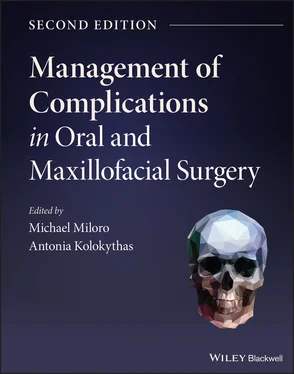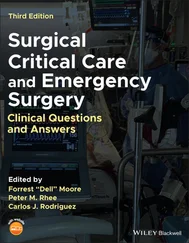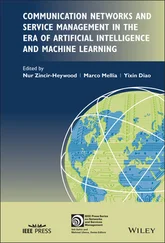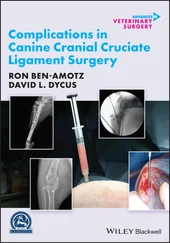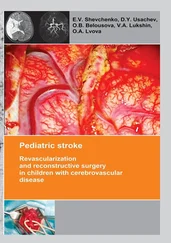Fayette Williams, DDS, MD, FACSDirector Division of Maxillofacial Oncology and Reconstructive Surgery John Peter Smith Hospital Fort Worth, Texas
Waleed Zaid, DDS, MSc, FRCD(c), FACSAssociate Professor – Site Director of Baton Rouge Oral and Maxillofacial Surgery Department Louisiana State University Health Sciences Center New Orleans, Louisiana
Vasiliki Karlis, DMD, MD, FACS
Lauren Bourell, DDS, MD
Robert Glickman, DMD
Ambulatory anesthesia is one of the more common adjunctive procedures performed by an oral maxillofacial surgeon (OMS) in private or academic practice. Anesthetic states ranging from mild sedation to general anesthesia are achieved, mainly through the use of intravenous (IV) agents, but occasionally with inhalational agents as well. When indicated, the provision of anesthesia can greatly facilitate many dentoalveolar and other outpatient surgical procedures, and enhances patient comfort and satisfaction as well as surgeon efficiency. Ambulatory anesthesia is frequently recommended to patients for procedures such as third molar removal, and many patients request anesthesia regardless of the planned surgical procedure. In the special case of pediatric patients, where patient cooperation can be unreliable and anxiety is frequently at a high level, the utility of ambulatory anesthesia can be even greater. In both children and adults, ambulatory anesthesia allows for more procedures to be performed in an outpatient setting than would otherwise require an operating room (OR) procedure with potential increased risks and costs.
Provided the many benefits of outpatient anesthesia, it is not surprising that a great number of anesthetics are performed each year by OMSs in outpatient settings. Adjunctive anesthesia is provided to thousands of patients each year, and the number of complications reported during the provision of ambulatory anesthesia remains quite low, generally less than 1% incidence in anesthetic cases [1]. Of these reported complications, serious adverse events comprise an even smaller number. Much conscientious effort has gone toward ensuring the safety of ambulatory anesthesia, particularly in the areas of surgeon training, complication prevention, patient monitoring, and emergency protocols. While OMSs may exhibit confidence in the use and safety of ambulatory anesthesia, they must also maintain a high level of vigilance in order to prevent anesthetic complications and appropriately manage them when they arise.
Many OMSs who provide anesthesia in an outpatient setting also perform surgery in a hospital OR, and there is frequently overlap in the types of surgical procedures that are performed in either setting. However, there are some notable differences in the anesthetic as it is conducted in the OR versus an outpatient facility. In the OR, the anesthesia is nearly always provided by someone other than the surgeon, typically by an anesthesiologist or certified registered nurse anesthetist. This allows the surgeon to focus single‐mindedly on the surgery at hand. In contrast, in outpatient anesthesia, the OMS typically acts as surgeon–operator, or the “operator–anesthetist” model, providing the anesthesia and performing the surgery simultaneously. Support for this dual role of the OMS can be gleaned from data demonstrating a very low incidence of anesthetic‐related complications in outpatient settings where surgeon‐operators administered the anesthesia and performed the surgery [1]. The administration of outpatient anesthesia requires extra attention from the surgeon who must monitor both the anesthesia and the surgical procedure simultaneously. Maintaining this balance of attention can be challenging, and may require a different set of skills than those utilized in the OR when focused solely on the surgical procedure.
Other important differences between anesthesia administered in the OR and ambulatory anesthesia can contribute to the relative safety of outpatient anesthesia. Two important factors are the greater risk and complexity of surgical procedures performed in an OR setting and the greater distribution of lower‐risk patients (ASA [American Society of Anesthesiologists] I and II) in outpatient settings versus higher‐risk patients (ASA III and above) who may be treated more frequently in the OR setting. These factors emphasize that careful patient and procedure selection contributes to the prevention of complications in outpatient anesthesia.
Lastly, patient monitoring equipment and emergency equipment available are often more extensive in the OR than in the outpatient setting, although this difference is becoming less due, in large part, to the decreased cost of equipment and technology. Certain invasive modes of patient monitoring, such as arterial or central venous lines, remain confined to the OR; however, many of the same modalities of monitoring cardiac and respiratory function exist for both OR and outpatient use. In addition, the OR emergency equipment has been reproduced for efficient use in the outpatient setting. The OR, by virtue of being located within the hospital, will retain an advantage in terms of broad emergency preparedness and access to trained staff, blood and tissue products, and specialist consultations. However, anesthesia in the OR setting can have increased risk due to increased complexity of surgical procedures and/or higher‐risk patient populations. These differences are important for the OMS who treats patients in both settings, because they have important implications for the prevention and management of anesthetic complications.
PREVENTION OF COMPLICATIONS IN AMBULATORY ANESTHESIA
Patient Characteristics/Selection
The best and most effective management of anesthetic complications is prevention of their occurrence. There is well‐documented evidence that certain perioperative patient characteristics contribute significantly to anesthetic and surgical risk. Some of these characteristics, such as patient age, are easy to quantify and have fairly predictable patterns of anesthetic risk. Other patient characteristics such as underlying medical conditions, medications, previous surgical history, allergies, cardiac and respiratory reserve, and body mass index (BMI) can be more difficult to assign risk. A detailed history and physical examination with appropriate preoperative laboratory workup and communication with the primary care physician are paramount in identification of those patients who may safely undergo anesthesia in an outpatient setting.
Several algorithms and classification systems for anesthetic risk based on patient characteristics are in common use, with the ASA criteria being among the most widespread (see Table 1.1). The utility of the ASA classification has been shown in scientific literature that demonstrates a clear association between ASA status (I–V) and the risk of anesthetic complications [2]. The ASA classification is widely recognized and simple to use, and it is a valid starting point into which other patient risk determinants can be incorporated. The Duke Activity Index is another useful measure of a patient's physical status. It presents a functional assessment of physical capacity based on an individual's exercise tolerance and ability to perform various activities of daily living (see Table 1.2). The ability to engage in exercise or everyday physical activities is inversely correlated with risk of anesthetic complications and provides an additional parameter for patient screening.
An adjunctive measure of patient risk for ambulatory anesthesia includes specific evaluation and classification of the airway. Mallampati's classification is a simple visual classification system, divided into four categories, which attempts to assess the posterior oropharyngeal airway patency based on the visibility of structures of the posterior oropharynx (uvula, fauces, soft and hard palates). The distance between the hyoid bone and the chin can be estimated as an additional, albeit crude, indicator of airway patency and ease of intubation with shorter mental–hyoid distances indicating greater airway risk. The thyromental distance is used to predict the difficulty of intubation and is measured from the chin to the thyroid cartilage with the head extended (<7.0 cm indicates the possibility of a difficult intubation). In addition, specific characteristics of patient body habitus such as obesity or the presence of a short, thick neck can be general predictors of risk of airway collapse during anesthesia. Head and neck movement can also be assessed and >90° is considered within normal limits. Of course, limited interincisal mouth opening, maxillary incisor proclination, a limited upper lip bite test, and a retrusive mandible may present risks for maintaining an airway and performing endotracheal intubation. Each of these anatomic and functional factors may be used to calculate an “airway score.”
Читать дальше
